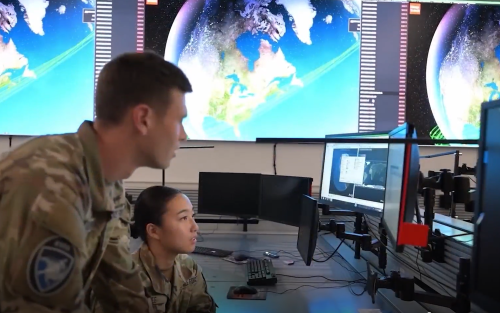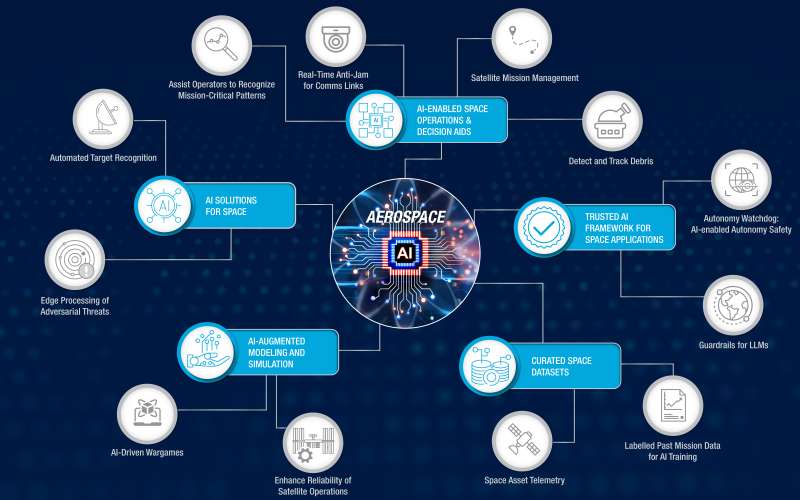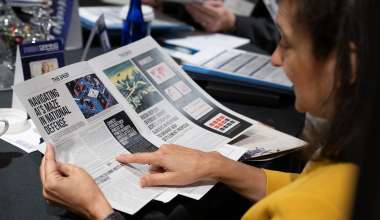Artificial intelligence offers vast potential for the space domain by enhancing satellite operations, predictive technologies and accelerated decision making. These advancements support more efficient missions and position the U.S. for strategic advantage in space. As AI capabilities continue to evolve, the growing pace of global innovation is elevating the importance of space for national security and beyond.
As the space domain becomes increasingly congested and contested, the ability to respond quickly and effectively is crucial to maintaining U.S. leadership in space. The Aerospace Corporation is advancing how AI-enabled tools can facilitate faster decision making to unlock impactful solutions for space’s hardest problems. Aerospace is leveraging AI, connecting across government and industry, to enable more data-driven insights that support mission-critical decisions.
“The velocity of technology coming out is incredible. Everything's being released at a breakneck speed,” said Lauren Perry, a principal engineer and scientist in the information systems and cyber division at Aerospace. “Aerospace and our partners need to build a future with AI that allows us to adopt emerging capabilities quicker and keep better pace.”
Outpacing the Threat with Applied Insights
In an environment where speed and agility are paramount, AI is a powerful enabler guiding key decisions. From real-time monitoring and threat detection to data analysis of space assets, AI supports earlier identification of risks—such as space debris or adversarial behavior—allowing teams to act with greater accuracy, confidence and decreased response time.

These capabilities can also improve satellite communications, optimize bandwidth and support autonomous navigation. AI-driven predictive maintenance can anticipate equipment failures, timely repairs and minimize downtime. Simulations and digital modeling using AI provide engineers with highly accurate representations of space systems, supporting design, testing and deployment.
Historical data is also a powerful resource. AI tools can analyze past missions to inform optimal launch windows, therefore reducing delays. It can potentially extend mission lifespans by recommending optimal fuel consumption strategies or improving communications infrastructure. These enhancements contribute to more streamlined and effective mission planning and execution.
“AI is different from past technologies. It is a generic platform, waiting for users to apply it and provide us, as developers, with the specific use cases,” said Shawn Sloan, Corporate AI Technical Fellow in the Digital Innovation Division. “The industry is moving towards democratizing this capability, commoditizing it and then letting everyone use it. And we're here to help each step of the way.”
Connecting End-to-End
When employed strategically, AI helps bridge connections across the full spectrum of mission needs— from government and commercial partnerships to technical execution. Aerospace is pursuing a seamless AI strategy that supports efforts to integrate capabilities across mission phases, supporting situational awareness and coordination across the evolving space environment. By enabling end-to-end connectivity, Aerospace ensures that every element of a mission—design, planning, launch and operation—work together. Automating routine tasks, surfacing actionable insights and improving interoperability, AI supports operational efficiency and overall mission success.
As with any new technology, Aerospace is committed to ensuring these tools meet the highest standards for security and performance, while keeping at the forefront of innovation.
Embracing rapid change requires building the necessary trust to integrate these new technologies. Widespread adoption builds over time through demonstrated benefits and proven performance. Aerospace is strengthening this trust through initiatives like the Trusted AI Framework, which will provide guidance, resources and training to support AI fluency and responsible integration across the space sector.

Aerospace continues to lead from the front, developing and implementing novel solutions to support space operations.
“AI is enabling us to empower our experts in ways they haven’t been before. If applied effectively, AI can connect more experts to solve more hard problems,” said Perry. “Then, these people don’t need to be an expert in any specific tools; they can be an expert in their entire role for the mission, which is a new approach.”
AI tools are enabling better decisions, faster responses to threats and enhanced coordination across systems. With its unique role as the trusted partner to government and industry, Aerospace is shaping the future of space operations—one that is more efficient, resilient and interconnected through the responsible application of AI.





